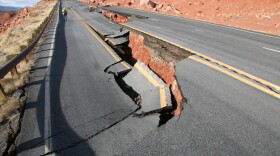Most people are squeamish about the notion of consuming recycled wastewater. But experts say we might have to get used to the idea, given our current drought and the growing population in the Southwest. How does that water get clean enough to drink?
In Las Vegas all the water that cleans the dishes, hits the shower drain or is flushed down the toilet is recycled at this plant.
The waste flows through 2,000 miles of pipes to arrive in a torrent here. Jeff Mills is the assistant manager of plant operations for Clark County Water Reclamation District.
“It’s not probably as dark as what you might think because 99.9 percent of that is carrier water bringing it down in the collection system,” Mills said as he held up a plastic container of what’s called influent — the waste piped into the plant.
Mills took me through step by step how everything is filtered out — egg shells, coffee grounds and sludge. He explained how the good bacteria eat up chemicals harmful to the environment and finally how ultraviolet light bulbs disinfect the water.
Water pollution control laws in the 1940s and ’50s provided federal money to build wastewater treatment plants like this one. Much of that water is now reused on golf courses, in air conditioners and car washes. In some cases it flows back into the environment, like the Las Vegas Wash.
“If you come in and the fish don't see you, you should see a good half dozen good size carp,” Mills said as we spot a giant fish swimming near the surface.
From the Las Vegas Wash the water flows 25 miles downstream to Lake Mead, the massive reservoir that supplies water to Southern California, Arizona and Las Vegas. But the recharge won’t do much to bolster Lake Mead. It’s so low, the Southern Nevada Water Authority is building a new pipe to pump water to Las Vegas.
Engineering Project Manager Erika Moonin took me to a platform where I can look down a 600-foot-deep shaft that’s 30 feet in diameter.
Warm, humid air mists up my camera lens and my glasses. Moonin says they’re building this pipeline to take cleaner water from the bottom of the lake.
"That treated wastewater gets trapped at the surface," Moonin said. "So if we’re deep enough we don’t see the influence of that treated wastewater coming into our intakes."
Some water experts worry about what the wastewater treatment plants don’t remove — traces of pharmaceutical drugs for instance. Robert Glennon is a regents professor at the University of Arizona and the author of Unquenchable: America's Water Crisis and What To Do About It.
“Now they’re in exceedingly small doses measured in the parts per trillion, but they're still powerful chemicals,” Glennon explained. “And we don’t know what the maximum safe exposure level is for any one of these chemicals, never mind that it's really a veritable cocktail mix of chemicals.”
So far research shows no harmful health impacts in places like Namibia, where people are already drinking recycled water without an environmental buffer like a lake. But more studies need to be done. In the meantime Glennon said that water can be used on parks or to wash cars.
“When most of us think about the water that we have, we think of it as though it were like air — infinite and inexhaustible,” Glennon said. “When for all practical purposes its very finite and very exhaustible”
Glennon said all water is essentially recycled dinosaur pee. There’s no more water on the earth today than there was when dinosaurs roamed it. The problem, according to Glennon, is we haven’t sustained the supply. So the water isn’t where we need it, when we need it, in the form that we need it. That’s why the Southwest is relying more and more on recycled water to stretch the supply.







